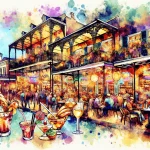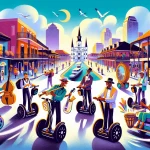Mardi Gras Day in New Orleans marks the climax of a captivating cultural celebration that has enthralled the city for centuries. This annual event exemplifies the rich heritage and traditions that have shaped New Orleans’ distinct identity.
In This Article
TL;DR
- Mardi Gras Day is the pinnacle of the Carnival season, a time of revelry, parades, and cultural expression.
- Elaborate costumes, colorful masks, and iconic throws like beads and doubloons are integral to the festivities.
- Traditional dishes like king cake, gumbo, and jambalaya, along with signature cocktails, are an essential part of the Mardi Gras experience.
Historical Context of Mardi Gras in New Orleans
The roots of Mardi Gras in New Orleans trace back to the city’s French and Spanish colonial roots. The first recorded Mardi Gras celebration occurred in 1699 when French explorers landed near present-day New Orleans and held a small festival. Over the years, the festivities evolved, incorporating elements from various cultural influences, including Native American, African, and Creole traditions.
One of the most significant figures in shaping the modern Mardi Gras was the Krewe of Rex, established in 1872. This organization introduced the iconic colors of purple (justice), green (faith), and gold (power), which have become synonymous with the celebration. The Krewe of Rex also established the tradition of a grand parade with elaborate floats and costumes, setting the stage for the spectacle we witness today.
Understanding Mardi Gras Day Celebrations
Mardi Gras Day, also known as Fat Tuesday, marks the final day of the Carnival season before the start of Lent. The day’s festivities begin at dawn with the Zulu parade, one of the most anticipated events of the season. This parade, organized by the Zulu Social Aid and Pleasure Club, features vibrant costumes, music, and a unique blend of African and Creole traditions.
As the day progresses, the streets of New Orleans come alive with a series of parades organized by various krewes, each with its own distinct theme and artistic expression. These krewes, which are social organizations responsible for organizing the parades, channel their creativity into designing elaborate floats, costumes, and throws that captivate the crowds lining the parade routes.
Parade Routes and Viewing Strategies
Two of the most famous parade routes in New Orleans are St. Charles Avenue and Canal Street. These iconic thoroughfares become the epicenter of the Mardi Gras celebrations, with crowds gathering early to secure prime viewing spots. To ensure a safe and enjoyable experience, it’s essential to arrive well in advance, dress comfortably, and follow crowd management guidelines provided by local authorities.
Traditional Foods and Drinks
No Mardi Gras experience would be complete without indulging in the city’s iconic culinary delights. The king cake, a sweet brioche-like pastry adorned with purple, green, and gold sugar, is a staple of the season. Other must-try dishes include jambalaya, a savory rice dish with meat and vegetables, and gumbo, a hearty stew that showcases the city’s Creole and Cajun influences.
Complement your culinary adventures with signature cocktails like the Hurricane, a potent rum-based drink, or the Sazerac, a classic New Orleans cocktail made with rye whiskey and bitters. Local craft breweries also offer a range of unique beers that perfectly complement the festive atmosphere.
Music and Entertainment
Music is an integral part of the Mardi Gras celebrations, with the streets of New Orleans resonating with the sounds of brass bands, jazz ensembles, and local musicians. Many venues throughout the city host live performances, allowing visitors to immerse themselves in the vibrant musical culture of New Orleans.
Cultural Significance and Community Impact
Mardi Gras is more than just a celebration; it is a deeply ingrained part of New Orleans’ cultural identity. The festivities bring together people from all walks of life, fostering a sense of community and unity. The economic impact of Mardi Gras on the local economy is significant, with millions of visitors flocking to the city each year, supporting businesses and generating revenue.
Additionally, many krewes and organizations use Mardi Gras as a platform to raise funds for charitable causes, contributing to the betterment of the community. This spirit of giving back further solidifies the cultural significance of Mardi Gras in New Orleans.
Practical Tips for Visitors
To fully experience the magic of Mardi Gras Day, it’s essential to plan ahead. Arrive in New Orleans a few days before the main event to acclimate to the festive atmosphere and secure accommodations. Consider staying in the French Quarter or nearby neighborhoods for easy access to the parade routes and festivities.
Dress in layers and wear comfortable shoes, as you’ll be spending a significant amount of time on your feet. Carry essentials like water, snacks, and a portable charger for your devices. Most importantly, embrace the spirit of Mardi Gras and immerse yourself in the vibrant culture and traditions that make this celebration truly unforgettable.
Mardi Gras Day in New Orleans is a cultural experience like no other, a celebration that transcends mere revelry and embodies the city’s rich heritage, resilience, and joie de vivre. Whether you’re a first-time visitor or a seasoned local, this annual event is sure to leave you with memories that will last a lifetime.






